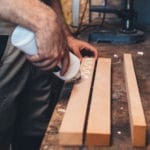Whether you’re working on a dollhouse or a real house, if it is made of wood, you need a great glue to get you through the project.
The best wood glue will be able to create an effective adhesive to ensure the integrity of the result, but finding one isn’t easy!
In our guide below, we’ll be taking a look at some of the best wood glue brands and providing you with some useful tips that will help you understand how to choose one.
No matter how big (or small) your project is, these products will provide you with the solid bond that you’re looking for.
Top 10 Wood Glue Comparison Table
| Picture | Name | Quantity | Price | Rating (1-5) |
|---|---|---|---|---|

| 1. Titebond Franklin International 1414 Titebond-3 Ultimate Wood Glue | 16 oz. | $$ | 4.8 |

| 2. Gorilla Wood Glue, 18 oz | 18 oz. | $$ | 4.7 |

| 3. Titebond III Ultimate Wood Glue, 8 Oz (1413) | 8 oz. | $$ | 4.7 |

| 4. Titebond Franklin International 1416 Titebond-3 Ultimate Wood Glue | 1 gallon | $$$$ | 4.9 |

| 5. Elmer's E7010 Carpenter's Wood Glue, Interior, 8 Ounces | 8 oz. | $ | 4.7 |

| 6. Glue Masters Professional Grade Cyanoacrylate (CA) "Super Glue" | 2 oz. | $$$ | 4.5 |

| 7. Satellite City Hot Stuff Thin Instant CA Glue, 2oz HS-4 | 2 oz. | $$$ | 4.6 |

| 8. Rhino Glue Pro Kit | 8 g | $$$ | 4.5 |

| 9. Gorilla Epoxy, .85 oz., Clear | 0.85 oz. | $$ | 4.6 |

| 10. Gorilla Super Glue Gel, 15 g | 15 g | $$ | 4.5 |
Tips for Finding Wood Glue
Wood glue can prove beneficial for use in any room in the house, as well as in the exterior. Due to this, check whether the glue is waterproof to ensure that it is suitable for all uses.
Determine how much you will need for your project by considering the surface area of the wood you will be working with and the size of the project. Bear this in mind when thinking about the quantity that you need.
If possible, wear gloves whilst using the glue, or if this is not practical, ensure that you wash your hands soon after using it to remove any residue.
Check which wood you are working with to determine whether you require a particular type of glue.
In case of accidents, check what steps are necessary to clean up the glue and do so before it dries to prevent the unsightly marks that can result from glue drying in the wrong place.
To get the most benefit from wood glue, it is important to use it correctly and the instructions must be read before use to determine what this is. It will normally include:
- Start by gathering all the components required as part of the project for which the glue is required, ensuring that they are close to hand.
- If in doubt, test it by squeezing a small amount onto a hidden section of the wood, such as the underside of a piece of furniture. Leave it to dry and check how it looks afterwards.
- Ventilate the working area and clear it of any unnecessary apparatus to avoid the risk of accidents.
- You may need to clean the wood before using any adhesive to ensure the best possible chance of it sticking properly.
- In some cases, you may need to sand or plane the wood first to create a smooth surface. After this, take the time to clean off any sawdust and debris.
- Carefully apply the glue – spreading with a spatula, if necessary – and immediately attach to the other surface.
- Use a clean cloth to wipe away any drips.
If necessary, wipe the components beforehand with a dry cloth to remove any dust or dirt that may be on the surface, which could interfere with the glue’s ability to adhere properly. This step is especially relevant if it is necessary to complete any treatment to the surface area first, such as sanding.
If there is only a small surface area over which the glue needs to be applied, it is prudent to ensure that it is carried out precisely with the use of a spatula, so that it can be spread evenly and thoroughly.
Top 5 Best Wood Glue Reviews
1. Titebond Franklin International Titebond-3

Titebond Franklin International 1414 is a 16oz bottle of glue that is designed for use with wood. It comes in a squeezable bottle that is topped with a slim nozzle that makes it simple to apply the glue directly to the required surface.
The texture of the glue is a thick liquid that can be spread with a spatula to create a thin layer.
It still works well regardless of the finish that might have been used on the wood, so there is no need to undertake any other treatment first.
It is resistant to heat and mildew and is suitable for use both indoors and outdoors, so it can be used in all different scenarios.
Titebond Franklin International 1414 is the best wood glue as it is effective and easy to use.
2. Gorilla Wood Glue, 18 oz

Gorilla Wood Glue is a water-based adhesive that can be used for a range of projects that involve wood. Not only is it suitable for use with small woodworking projects and repairs, but also for larger building projects.
This makes it ideal for all types of wood.
It has a texture that allows it to be spread thinly to the relevant surface and works quickly to form a superior bond.
Clamping the treated wood for 20 – 30 minutes is sufficient to create the bond and it takes 24 hours.
It is water-resistant to ANSI/HPVA Type II and can be used effectively for both indoor and outdoor projects.
For the peace of mind of using a well-known brand, Gorilla Wood Glue will hit the mark.
3. Titebond III Ultimate Wood Glue

Titebond III is an 8oz bottle of glue that comes in a slim-shaped bottle that makes it convenient to hold, and the nozzle ensures as precision as possible during application.
The shape of the bottle also makes it easy to store as it does not require much space.
It is non-toxic and does not contain any solvents, so it is safe for everyone to use and does not have an offensive odor. This also makes it easy to clean up with water and is safe for indirect contact with food, such as for kitchen repairs, like fixing a countertop or chopping board.
The water-resistant formula provides a strong adhesive effect after the initial tack, which passes the ANSI/HPVA Type 1 level.
Whether it has been used for an internal or external application, the process for removing this glue is simple as it can be sanded.
Titebond III has great adhesive qualities to make it ideal for use around the home.
4. Titebond Franklin International Titebond-3

For occasions when you will need a large quantity of glue, Titebond Franklin International 1416 will often fit the bill as it comes in a sturdy gallon jug that makes it easy to pour. This also makes it easy to decant into a small receptacle when you only require a small amount.
It goes on smooth and has a strong initial tack that builds to create a strong bond to keep wooden components in place. This ability remains even in humid conditions, and it is also waterproof to a point where it can pass the ANSI/HPVA Type I specification.
The swift initial tackiness means that it is not necessary to undertake a significant period of clamping in order to achieve a firm bond, which can make large projects easier.
The formula is safe for use for non-direct food contact.
For a glue that provides a strong bond, Titebond Franklin International 1416 is the way to go.
5. Elmer’s E7010 Carpenter’s Wood Glue

Elmer’s E7010 is a wood glue that is designed for use for carpentry projects and small wood household repairs.
The bottle is shaped to make it easy for this use as it can be applied directly to the relevant surface due to the position of the nozzle.
The formula is non-toxic and can be used on all types of wood to create a bond that has a strength that equates to the existing wood. It is easy to clean up when necessary, and the use of this glue does not create any significant fumes.
The 8oz bottle is a convenient amount for a range of tasks.
Elmer’s E7010 glue is a great addition to any carpenter’s kit.
Different Types of Wood Glue
Wood glue comes in many different varieties, and knowing the difference between them can help you choose which is best for your needs.
For instance, there are single-use glues that require heating before application or ones designed to be used only once while other adhesives may need several applications based on their varying temperatures required during a set time.
- Polyvinyl acetate (PVA) – It is a versatile glue that can be used in many different applications, from woodworking and hobby crafting to adhesive promotions. It’s also non-toxic, water-soluble, and affordable – allowing you to shift your work before it dries up significantly with no risk of breaking anything.
- Epoxy – If you want to seal your deck and avoid future problems, epoxy is a great option. It comes in two parts: resin which contains the glue itself, curative that helps create hardening when mixed with time or sunlight exposure (which makes it tough). You can use this stuff outdoors and indoors without worrying about getting too much moisture on top of them since they’re waterproof.
- Cyanoacrylate (CA) – This is a glue that can be used to attach plastic pieces, especially those for hobbyists who are working with wood. It bonds quickly and provides an awesome bond once dried.
- Polyurethane – It is a strong and durable adhesive. It can be used to glue various materials together, but it’s not recommended for fine arts like antiques because polyurethanes are vulnerable in UV light so they should never be exposed outdoors.
Frequently Asked Questions
What Wood Glue Do Carpenters Use?
Gorilla Wood Glue is one of the most well-known and trusted brands in wood glue. The name “gorilla” was chosen for its strong adhesive properties, but whether or not this means that these creatures are particularly talented at sticking things together remains a mystery!
What is the Strongest Exterior Wood Glue?
One of the most durable wood glues is polyurethane. This strong, versatile glue makes for a perfect project both indoors and out as it has waterproof qualities that allow you to work outdoors with no worries about getting wet or dirty (it also has exceptional UV resistance).
The adhesive will dry in an invisibly soft natural color so your finished product looks seamlessly blended into its surroundings – all thanks to this great multipurpose adhesives power.
Is Wood Glue as Strong as Screws?
Wood glue is a fantastic way to bond two pieces of wood together. It’s stronger than screws because it can grip the entire surface area, not just where there are sharp edges as with metal fasteners like nails or pilings – which means your project will be more stable and last longer.
How Long Should You Wait for Wood Glue to Dry?
The drying time for wood glue can vary depending on what brand and type you use. Titebond recommends 30-60 minutes while other brands recommend 24 hours or more before stress is applied to the joint.
Do I Need to Clamp Wood Glue?
You may know wood glue is a strong adhesive that can take time to set up. To help with this, we often use clamps while waiting for it dry so the pieces stay together during its drying period.
What is the Fastest Drying Wood Glue?
Titebond’s multi-surface glue, with a thicker consistency and faster drying time than other water-based glues on the market, is ideal for use in situations where you need to stick two materials together.
The ability this product has of bonding most surfaces means it will work as long as its bond holds up against pressure or weight.
Conclusion
Choosing the right glue for your project is a lot like picking out dinner. You may have a favorite dish but at times, something different can be just as delicious. In this article, we’ve given you some of our top picks and now it’s up to you to decide which one will work best for you.
Have fun with it and find what works best in terms of both performance and price point–you won’t regret it!




